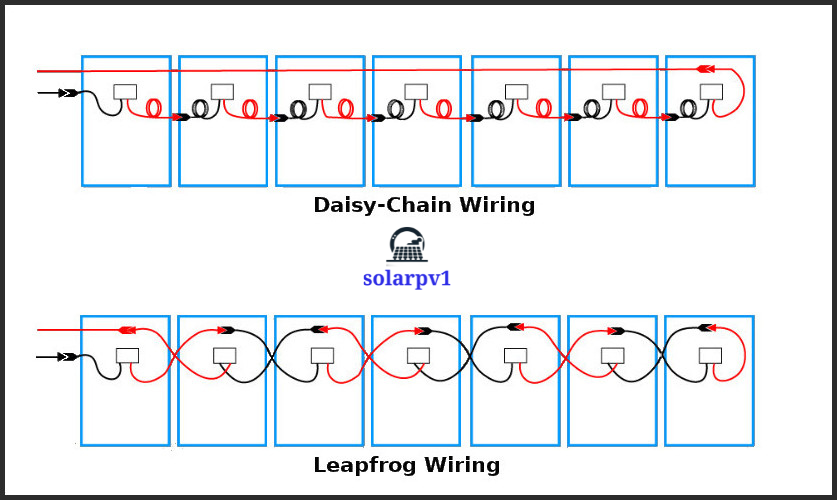Solar Panels Wiring Technique : Daisy-Chain Technique vs Leapfrog Technique
When it comes to installing solar panels, one of the important considerations is the wiring technique. Two popular methods used are the daisy-chain technique and the leapfrog technique. In this article, we will explore the differences between these two approaches and discuss their advantages and disadvantages.

1. Daisy-Chain Technique
- The daisy-chain technique involves connecting the solar panels in a series, where the positive terminal of one panel is connected to the negative terminal of the next panel, forming a chain-like configuration. This method is commonly used in residential and small-scale installations.
- One of the main advantages of the daisy-chain technique is its simplicity. It requires fewer wires and connectors compared to other wiring methods, making it cost-effective and easy to install. Additionally, this technique allows for easy expansion of the solar panel system by simply adding more panels to the existing chain.
- However, there are some drawbacks to consider. In a daisy-chained configuration, the performance of the entire system is dependent on the performance of the weakest panel in the chain. If one panel is shaded or malfunctions, it can significantly affect the overall output of the system. Moreover, the voltage drop across the chain can be higher compared to other wiring techniques, resulting in reduced efficiency.
2. Leapfrog Technique
- The leapfrog technique, also known as parallel wiring, involves connecting the solar panels in parallel, where the positive terminals are connected together and the negative terminals are connected together. This method is commonly used in larger-scale installations and commercial projects.
- One of the main advantages of the leapfrog technique is its ability to mitigate the impact of shading or panel malfunctions. Since the panels are connected in parallel, the performance of one panel does not affect the performance of the others. This ensures that the overall output of the system remains stable even if there are issues with individual panels.
- Another advantage of the leapfrog technique is its lower voltage drop compared to the daisy-chain technique. By connecting the panels in parallel, each panel contributes to the overall voltage, resulting in a more efficient system. Additionally, this wiring method allows for easier monitoring and maintenance of individual panels.
- However, the leapfrog technique has some drawbacks as well. It requires more wiring and connectors compared to the daisy-chain technique, making it slightly more expensive and complex to install. Moreover, expanding the system using the leapfrog technique may require additional equipment to handle the increased current.
Final Thoughts
- Both the daisy-chain technique and the leapfrog technique have their own advantages and disadvantages when it comes to solar panel wiring. The daisy-chain technique offers simplicity and cost-effectiveness, but it is more susceptible to shading and has a higher voltage drop.
- On the other hand, the leapfrog technique provides better performance in shaded conditions and has a lower voltage drop, but it requires more wiring and may be slightly more expensive.
- Ultimately, the choice between these two techniques depends on the specific requirements of the solar panel installation. Factors such as the size of the system, the presence of shading, and the budget will influence the decision. It is important to consult with a professional solar installer to determine the most suitable wiring technique for your project.
